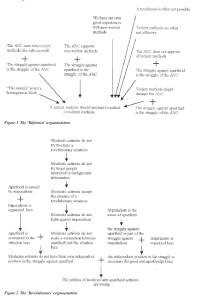ISSA Proceedings 1998 – The Cake Or The Bakery? The Conceptual Structure Of Debates Between ‘Revolutionaries’ And ‘Reformists’
No comments yet 1. Introduction: ‘revolutionaries’ and ‘reformists’
1. Introduction: ‘revolutionaries’ and ‘reformists’
Within most political groups, parties, movements or organizations there is debate between radical and moderate people or groups. A well known example is the debate between revolutionaries and reformists[i] in most European socialist parties at the beginning of the 20th century (Etty 1996, Van Dijk 1982). Modern political parties are plagued by this conflict too, see the debate between ‘fundis’ and ‘realos’ in the German Green Party. But also within so-called new social movements radical and ‘reformist’ wings are fighting each other. In the Dutch women’s movement of the seventies and eighties it was the radical feminists against the ‘careerfeminists’ (Brunt 1979). Within the current anti-fascist movement it is the arrived, ‘neutral’ organizations against the anarchist ‘antifas’(BILWET 1990).
Debates of this kind occur quite often because radical and moderate groups are more involved with eachother than some of their members would admit. As time goes by, lots of groups get closer to their the once loathed enemies: moderate groups get more radical, radical groups loose their sharp edges. Apart from that, radical and moderate groups are often concerned with the same issues. Almost every supposedly too moderate group gets competition from a radical one. In spite of this kind of competition, radical and moderate groups are not drawn into debates because they have completely opposite views. Both groups share at least some general opinions about what is wrong and what is right. Their difference of opinion is about strategy in the broad sense of the word. So debates between ‘revolutionaries’ and ‘reformists’ are about matters like ‘what is useful and important to strive for’. An example of this is the debate in the anti-fascist movement I mentioned before. Although the starting point of this debate was the use of violence by the radical ‘antifas’, the debate has never just been about means. Far more important are the different strategies of both groups: the ‘reformists’ see fascism as a political threat that should be met with a political massmovement; the radicals see fascism as a threat to their lives, therefore self-defense is their first priority.
All these debates between ‘revolutionaries’ and ‘reformists’ differ from each other, but I am interested in what they have in common: their conceptual structure, i.e. the starting-points and patterns of reasoning. In order to get a hold on this structure I have analysed one clear example of a debate between ‘revolutionaries’ and ‘reformists’.
 2. The Apartheid debate
2. The Apartheid debate
This example is a debate between radical and moderate Dutch anti-apartheid activists which appears in the 1988 issues of the anarchist magazine ‘De Zwarte’. The moderate South Africa Movement was protesting against apartheid since the beginning of the sixties. They tried to influence the Dutch government and companies to take measures against the South African goverment. They became well-known for organizing boycotts on companies that invested in South Africa; one of the largest boycotts was aimed at Shell (Anti-apartheidskrant, 1990). In the eighties, activists from the squatter and anarchist movement got involved with this struggle as well. One of their activities consisted of assaults on Shell-filling stations. At the end of the eighties this so-called ‘pump-slashing’ became quite popular among radical activists in the Netherlands, Denmark, Germany and other West European countries. In Western Europe more than 120 filling stations were damaged (Buijs 1995). ‘De Zwarte’ was a small magazine that was made by and for radical activists.
I have analyzed the debate using the method of Fisher (1988). What follows is a summary of the debate, for a more detailed account of the last two parts of the debate see the diagrams. The debate started when some radical anti-apartheid activists did damage to several Shell filling stations. In a statement the activists explained their actions and at the same time they criticized a group of moderate activists. They claimed that the moderate group kept silent about ‘the political, military and economic interests behind apartheid’ and that their politics were nothing but a ‘chain of words’.
Some moderate people reacted to this criticism, but in the first place they reacted to the actions of the radical people. They put forward that the radicals have good insights into the background of apartheid (the ‘political, military and economical interests’), but that such a ‘radical analysis’ should not lead to violent actions. The reasons they gave for this were that violent actions outside South Africa are not approved by the ANC (the African National Congress), the main South African anti-apartheid organization at the time. Their opinion should be valued highly, because the struggle against apartheid is ‘in the first place the struggle of the ANC’. Added to this, non-violent action is a good alternative. According to the moderate group even ‘the system’ can be fought from the inside by non-violent means, because this ‘system’ is already plagued by inner contradictions.
The radical people reacted to this. Their main point was that the politics of the moderate group were wrong because they saw apartheid as a matter of foreign politics, instead as a result of omnipresent imperialism. Imperialism is not a matter for foreign politics, because it is organised ‘right around the corner’. According to the radicals the struggle against apartheid was not ‘the struggle of the ANC’, but the struggle of everyone who is a victim or adversary of imperialism. In short: ‘their struggle is our struggle’.
3. Explaining the debate
In search for the principal conceptual structure that underlies this conflict (and similar conflicts), I have tried to explain this debate in terms of the well known general characterization ‘reformists want just one cake, revolutionaries want the whole bakery’. The reason I did so was that this slogan was the only clue I had about debates between ‘revolutionaries’ and ‘reformists’. I have interpreted the slogan as follows: the ‘reformists’ want ‘just one cake’ because they value realizability more than desirability. They strive for something that is very likely realizable like a 1% rise (yes, ‘the cake’), rather than for something that is highly desirable, but very likely not realizable like a complete change of the world (in other words: ‘the bakery’). With the ‘revolutionaries’ it’s the other way round. A debate arises when both parties are concerned with one issue and realizablity excludes desirability. This interpretation is quite popular, thus Brunt (1979: p72) describes the conflict between radical and ‘carreerfeminists’ as follows: “the radicals reproach the reformists lack of vision and courage, the latter reproach the former of being unrealistic”.
However, the debate in ‘De Zwarte’ could not be explained in these terms. The moderate people didn’t in the first place oppose the radicals because they strive for things that are not realizable. Most of their criticism was aimed at the means the radicals use, i.e. violence. This criticism and their view of the anti-apartheidsstruggle was mainly based on their respect for the ANC. They rejected violent actions because these actions were supposed to collide with the interests of the ANC. Likewise the argumentation of the radicals couldn’t be fitted into the realizability/desirability dichotomy. Altough the radicals argued for getting at big things (‘the bakery’) like a revolution against imperialism, they did not do so because of the desirability of such a revolution. If they did, one would expect arguments about the need for a world free of imperialism. However, such arguments are not used by the radicals. Instead a large part of their argumentation is about the relation between apartheid and imperialism. The primary issue in the anti-apartheid debate was not the desirability of a revolution or the realizability of reforms.
Looking at the contents of the debate itself provided a better way of discovering the underlying conceptual structure. As I have explained, the ‘reformists’ critizised the violent means the ‘revolutionaries’ used, whereas the ‘revolutionaries’ accused their opponents of lack of insight into the backgrounds of apartheid. Yet, the real controversy was not about violence or the backgrounds of apartheid. Actually the views of both parties on these points were not that different. The ‘revolutionaries’ did not see violence as the best way to reach a goal. The ‘reformists’ agreed with the ‘revolutionary’ view of the backgrounds of apartheid, they even advocated ‘a radical change of the current capitalist world order’. What kept both parties apart was a difference of opinion about the leadership of the anti-apartheidstruggle.
Both parties assumed that those who are most affected by apartheid are in a sense the owners of the struggle against it, which means that they have the right to decide about the course of the struggle. According to the ‘reformists’ the victims of apartheid are most affected, therefore the leadership of the struggle should reside with the black people of South Africa, represented by the ANC. According to the ‘revolutionaries’ everyone who has to deal with imperialism (the cause of apartheid) is affected by apartheid, therefore all victims and adversaries of imperialism have the right to decide about the struggle against apartheid. As one can see, the leadership-controversy is caused by different views of apartheid. For the ‘reformists’ apartheid is a relatively autonomous problem, whereas ‘revolutionaries’ see it in the first place as a result of imperialism.
4. Conclusion: the conceptual structure
To put in general terms the conceptual structure of the debate: both ‘reformists’ and ‘revolutionaries’ are concerned with specific problems (a 1% rise, apartheid, ‘the cake’) as well as general problems (a complete change of the world, imperialism, ‘the bakery’). But only the ‘revolutionaries’ make a strong connection between these two kinds of problems. According to them a specific problem can only be solved by paying attention to its deeper causes. The ‘reformists’ on the other hand, claim that specific problems can be solved piecemeal even if they have deeper causes. A debate arises if ‘revolutionaries’ and ‘reformists’ work on the same specific problem. The ‘revolutionaries’ highlight the general aspects of that problem in order to link it with the deeper causes. This leads to conflict with the ‘reformists’ who are inclined to pay more attention to specific aspects of a problem.
NOTES
i. In this article I often use these terms to describe all conflict between radical and moderate groups. I use quotation marks because these terms are not to be taken literally, not every ‘revolutionary’ talks about revolution all the time.
REFERENCES
Anonymous (1988). Persbericht [Pressreport]. De Zwarte 104, 3.
Anonymous/”refo” Nico (1988). Reaktie 2 op de persverklaringen in De Zwarte 104 [Second reaction on the pressrepeorts in De Zwarte 104]. De Zwarte 105, 7.
Anonymous (1988). De Stropdas van Olivier Tambo [The tie of Olivier Tambo]. De Zwarte 106.
De Anti-apartheidskrant (1990), 2 [newsletter published by the Anti-apartheid movement in the Netherlands].
BILWET [Foundation for the Advancement of Illegal Science, being established] (1990). Bewegingsleer. Kraken aan gene zijde van de media. [The Science of Movement. Squatting beyond the media], Amsterdam: uitgeverij Ravijn.
Brunt, Emma (1979). Je zal je zuster bedoelen. Eigentijds feminisme [My sisters keeper? Contemporary feminism]. Amsterdam: de Arbeiderspers.
Buijs, Frank J. (1995). Overtuiging en geweld: vreedzame en geweldadige acties tegen de apartheid [Convictions and violence: peaceful and violent actions against Apartheid] Amsterdam: Babylon-De Geus.
Dijk, Hans van (1982). De ideologische en organisatorische aspecten van het Tribune conflict 1907-1909 [The ideological and organizational aspects of the Tribune conflict 1907-1909], In: Cahiers over de geschiedenis van de CPN [Notebook on the history of the Communist Party of the Netherlands], 7, 49-87, Amsterdam: Stichting Instituut voor Politiek en Sociaal Onderzoek (IPSO).
Etty, Elsbeth (1996). Liefde is heel het leven niet. Henriette Roland Holst 1869-1952 [Love is not all life. Henriette Roland Holst 1869-1952]. Uitgeverij Balans.
Fisher, A. (1988). The Logic of Real Arguments, Cambridge: Cambridge University Press.
You May Also Like
Comments
Leave a Reply





